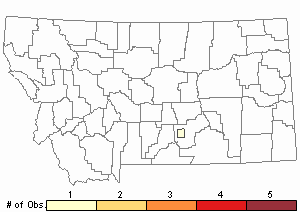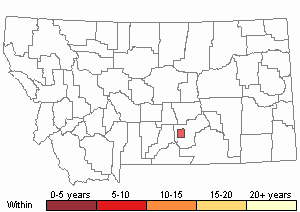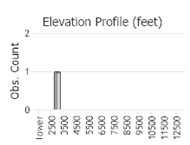View in other NatureServe Network Field Guides
NatureServe
Montana
Utah
Wyoming
Idaho
Wisconsin
British Columbia
South Carolina
Yukon
California
New York
Sword-bearing Conehead Katydid - Neoconocephalus ensiger
General Description
The following is taken from Rehn and Hebard (1914), Blatchley (1920), Helfer (1971), Vickery and Kevan (1985), Bland (2003), Capinera et al. (2004), Elliott and Hershberger (2007), and Himmelman (2009). This katydid is so named due the extremely long ovipositor of the female which can be longer than its body. The body color is grass-green (brown forms are known to occur) with a pale stripe extending from the cone tip and across the head and lateral edge of the pronotum. Also, a pale stripe occurs diagonally from behind the eye onto the lateral side of the face. The upper half of the ventral surface of the projecting cone (fastigium) is edged in black (see illustration). The hind tibia and the female ovipositor is brown. When disturbed, this species reacts in a variety of ways. It may sit still, or move to the opposite side of a plant stem, or quickly fall headfirst into dense vegetation and remain motionless with their fastigial cone embedded in the ground. In open areas, males often escape by taking flight and it has been noted that females are more difficult to find.
Calling song description
Verbal descriptions are: (1) “Stridulation consists of rapid, lisping pulses of about five per second (Bland 2003). (2) “The stridulation sounds like a rapid succession of pulses, ‘tsip, tsip, tsip, tsip,’ at about 10 per second…Opening the tegmina is silent, but closure produces a train of rapid decay pulses ending with an intense prolonged pulse” (Vickery and Kevan 1985). (3) “A series of rapid, lisping buzzes, like a fast-moving train. Calls begin at dusk and go well into the night” (Himmelman 2009). (4) “A rapid train of brief raspy notes…given at a rate of five to ten notes per second, depending on the temperature: tst-tst-tst-tst-tst-tst…Song is very loud and easily heard as one drives along country roads in late summer or early autumn. Starts singing at dusk and continues throughout night unless the temperatures drop too low. Males often sing in unison on cooler nights” (Elliott and Hershberger 2007). (5) “…This insect has but a single song and stridulates only at night, or during cloudy weather. It begins its song as soon as the sky is obscured or the sun near the horizon. It commences with a note like brw, then pauses an instant and immediately emits a rapid succession of sounds like chwi at the rate of about five per second, and continues them for an unlimited amount of time…its note to the syllable ‘ik-ik-ik,’ as if sharpening a saw, enlivening the low bushes and particularly the corn-patch, as it seems to…delight in perching near the top of a cornstalk and…giving…its song…” (Blatchley 1920).
Phenology
This species overwinters in the egg stage. The nymphs hatch in May-June. Adults occur from mid-July to mid-October, depending upon killing frost occurrence (Vickery and Kevan 1985, and Bland 2003).
Diagnostic Characteristics
The following comes from Rehn and Hebard (1914), Blatchley (1920), Helfer (1971), Vickery and Kevan (1985), Bland (2003), Capinera et al. (2004), Elliott and Hershberger (2007), and Himmelman (2009). The body length to the end of forewings is 24-26 mm for males, and 28-30 mm for females. The fastigium (anterior tip of the head, see illustration) for males is 3 mm, and females 3.2-3.5 mm. The pronotum, male and female, is 7-7.5 mm and the tegmina (forewing) for males is 37-42 mm, and females 44-48 mm. The hind femur for males is 20-21 mm, and females, 22-23 mm. The female ovipositor is 27.5-33 mm.
Due to this species’ size, morphology, present limited range and being the only species of Neoconocephalus occurring in the state, there should be little confusion with other katydids.
Species Range
Montana Range
Range Descriptions

 Native
Native
Range Comments
Occurs from the East Coast states and Nova Scotia, westward to south-central Montana, eastern Wyoming, north-central Colorado and New Mexico. From the north, in southern Quebec, Ontario and Manitoba, southward along the Appalachain chain of western North Carolina, and westward across Ohio, Indiana, Illinois, Missouri and Oklahoma. Occurrances in Nova Scotia, Manitoba, Montana, and Colorado are recent 21st century sightings. In Montana, the Sword-bearing Conehead Katydid has been reported only for Yellowstone County, and only in Billings in July 2006 (Vickery and Kevan 1985, Walker SINA 2020, and BugGuide.net).
Observations in Montana Natural Heritage Program Database
Number of Observations: 1
(Click on the following maps and charts to see full sized version)
Map Help and Descriptions
Relative Density

Recency



 (Observations spanning multiple months or years are excluded from time charts)
(Observations spanning multiple months or years are excluded from time charts)
Habitat
This species inhabits weedy fields, pastures, roadsides, prairies and wetland edges, and tends to favor habitats with moist conditions or water nearby. This species will also inhabit cornfields, perching 6-7 feet above the ground on a corn stalk or tassel, from which it often sings (Cantrall 1943, Vickery and Kevan 1985, and Bland 2003).
Food Habits
The Sword-bearing Conehead Katydid mostly feeds on seeds of grasses, less frequently on flowers, grass blades and parts of sedges (Bland 2003).
Reproductive Characteristics
When a sexually responsive female is attracted to a singing male, she moves vertically toward him by walking or occasionally flying. When the male detects her, he orients toward her, moves a few inches in her direction, and upon contact on a grass stem the pair move together and attenuate (touching with their antennae) each other. Copulation occurs quickly as the male arches his abdomen and they engage genitalia. He usually continues to stridulate until physical contact is made, his song becoming sporadic and stops upon full copulation. The copulating pair are positioned on the grass stem with the male pointed head downward and the female upward. Both the male and female use the tarsi of the first two pair of legs to grasp each other’s tegmina and supporting vegetation. Often the male grasps the female’s ovipositor. During the first few minutes of copulation, the male makes rhythmic movements of his subgenital plate and abdomen against the base of the female’s ovipositor passing his spermatophore. Copulation lasts from 27-68 minutes, usually the female initiates separation, upon which no spermatophore is visible (Gwynne 1977).
Stewardship Responsibility
References
- Literature Cited AboveLegend:
 View Online Publication
View Online Publication Bland, R.G. 2003. The Orthoptera of Michigan—Biology, Keys, and Descriptions of Grasshoppers, Katydids, and Crickets. East Lansing, MI: Michigan State University Extension, Bulletin E-2815. 221 p.
Bland, R.G. 2003. The Orthoptera of Michigan—Biology, Keys, and Descriptions of Grasshoppers, Katydids, and Crickets. East Lansing, MI: Michigan State University Extension, Bulletin E-2815. 221 p. Blatchley, W. 1920. Orthoptera of Northeastern America, section Phaneropterinae pp. 459-494. In: Nature Publishing, Indianapolis, IN.
Blatchley, W. 1920. Orthoptera of Northeastern America, section Phaneropterinae pp. 459-494. In: Nature Publishing, Indianapolis, IN. BugGuide. 2014. Identification, Images, & Information for Insects, Spiders & their Kin for the United States & Canada. Accessed 20 September 2021. https://bugguide.net/node/view/14481
BugGuide. 2014. Identification, Images, & Information for Insects, Spiders & their Kin for the United States & Canada. Accessed 20 September 2021. https://bugguide.net/node/view/14481 Cantrall IJ. 1943. The ecology of the Orthoptera and Dermaptera of the George Reserve, Michigan. Misc. Publications, Museum of Zoology, University of Michigan 54:1-182.
Cantrall IJ. 1943. The ecology of the Orthoptera and Dermaptera of the George Reserve, Michigan. Misc. Publications, Museum of Zoology, University of Michigan 54:1-182. Capinera, J.L., R.D. Scott, and T.J. Walker. 2004. Field Guide to Grasshoppers, Katydids, and Crickets of the United States. Ithaca, NY. Cornell University Press.
Capinera, J.L., R.D. Scott, and T.J. Walker. 2004. Field Guide to Grasshoppers, Katydids, and Crickets of the United States. Ithaca, NY. Cornell University Press. Elliott, L. and W. Hershberger. 2007. The songs of insects. New York, NY: Houghton Mifflin Harcourt. 227 p.
Elliott, L. and W. Hershberger. 2007. The songs of insects. New York, NY: Houghton Mifflin Harcourt. 227 p. Helfer, J.R. 1971. How to Know the Grasshoppers, Crickets, Cockroaches, and Their Allies. Revised edition (out of print), Mineola, NY: Dover Publications.
Helfer, J.R. 1971. How to Know the Grasshoppers, Crickets, Cockroaches, and Their Allies. Revised edition (out of print), Mineola, NY: Dover Publications. Himmelman, J. 2009. Guide to Night-Singing Insects of the Northeast. Mechanicsburg, PA: Stackpole Books. 160 p.
Himmelman, J. 2009. Guide to Night-Singing Insects of the Northeast. Mechanicsburg, PA: Stackpole Books. 160 p. Rehn, J.A. and M. Hebard. 1914. Studies in American Tettigoniidae. Transactions of the American Entomological Society x1:271-344.
Rehn, J.A. and M. Hebard. 1914. Studies in American Tettigoniidae. Transactions of the American Entomological Society x1:271-344. Vickery, V. R. and D. K. M. Kevan. 1985. The grasshopper, crickets, and related insects of Canada and adjacent regions. Biosystematics Research Institute, Ottawa, Ontario. Publication Number 1777. 918 pp.
Vickery, V. R. and D. K. M. Kevan. 1985. The grasshopper, crickets, and related insects of Canada and adjacent regions. Biosystematics Research Institute, Ottawa, Ontario. Publication Number 1777. 918 pp. Walker T.J.(ed.). 2020. Singing insects of North America. Accessed 10 February 2021. https://orthsoc.org/sina/
Walker T.J.(ed.). 2020. Singing insects of North America. Accessed 10 February 2021. https://orthsoc.org/sina/
- Additional ReferencesLegend:
 View Online Publication
View Online Publication
Do you know of a citation we're missing? Fulton, B.B. 1933. Stridulating organs of female Tettigoniidae (Orthoptera). Entomological News XLIV:270-275.
Fulton, B.B. 1933. Stridulating organs of female Tettigoniidae (Orthoptera). Entomological News XLIV:270-275. Gwynne, D.T. 1977. Mating behavior of Neoconocephalus ensigner (Orthoptera: Tettigoniidae) with notes on the calling song. The Canadian Entomologist 109:237-242.
Gwynne, D.T. 1977. Mating behavior of Neoconocephalus ensigner (Orthoptera: Tettigoniidae) with notes on the calling song. The Canadian Entomologist 109:237-242. Gwynne, D.T. 2001. Katydids and Bush-Crickets, Reproductive Behavior and Evolution of the Tettigoniidae. Ithaca, NY: Cornell University Press.
Gwynne, D.T. 2001. Katydids and Bush-Crickets, Reproductive Behavior and Evolution of the Tettigoniidae. Ithaca, NY: Cornell University Press.
- Web Search Engines for Articles on "Sword-bearing Conehead Katydid"
- Additional Sources of Information Related to "Insects"





